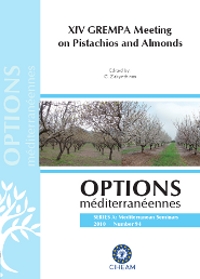| Article précédent | p. 65-69 | Article suivant |
Increase in the chill and heat requirements for blooming of the new almond cultivars
Almond (Prunus amygdalus (L.) Batsch) has been considered the earliest blooming fruit species, although it has become the species with the widest blooming range of all deciduous fruits after the release of the newly bred cultivars. Blooming of any cultivar takes place once its chill and heat requirements have been satisfied. Estimation of chill and heat requirements for blooming is very complex, due to the difficulty of assessing the theoretical date of transition from endodormancy to ecodormancy, when quantification of chill requirements ends and quantification of heat requirements starts. This date may be assessed by a statistical method based on the different effect of temperatures on blooming date depending on their incidence during endodormancy or ecodormancy. This method has been applied to obtain the chill and heat requirement of the almond cultivars released by the Centro de Investigación y Tecnología Agroalimentaria de Aragón (CITA). G-2-25 is an elite selection from the Zaragoza breeding programme, characterized by a very late blooming time. It shows 503 Utah CU, much higher than the other almond cultivars released by the CITA, such as 329 CU in Felisia or 353 CU in Aylés and Belona. It also shows a very high heat requirement, with 10233 Utah GDHºC, higher than 7221 GDHºC in Blanquerna or 9465 GDHºC in Felisia. These results show that the combined increase in chill and heat requirements in a genotype may ensure a late blooming season in all climatic conditions.
L'amandier (Prunus amygdalus (L.) Batsch) est considéré comme l'espèce fruitière à floraison la plus précoce, bien qu'elle soit devenue celle ayant l'intervalle de floraison le plus étendu de toutes les espèces fruitières après l'introduction des nouveaux cultivars améliorés. La floraison d'un cultivar arrive quand les besoins en froid et en chaleur sont satisfaits. L'estimation de ces besoins est très complexe, étant donné la difficulté à établir la date théorique de transition entre l'endo- et l'éco-dormance c'est-à-dire le moment où la quantification des besoins en froid finit et que commence celle des besoins en chaleur. Cette date peut être déterminée par une méthode statistique basée sur l'effet différent des températures sur la date de floraison en fonction de leur incidence pendant l'endo-dormance ou l'éco-dormance. Cette méthode a été appliquée pour obtenir les besoins en froid et en chaleur pour les cultivars introduits par le Centro de Investigacion y Tecnologia Agroalimentaria de Aragon (CITA). G-2-25 est une sélection élite du programme d'amélioration génétique de Zaragoza, caractérisée par une date de floraison très tardive. Elle a montré 503 Utah CU, beaucoup plus que les autres cultivars d'amandier obtenus par le CITA, comme 329 CU pour Felisia ou 353 CU pour Aylés et Belona. Elle a aussi montré de grands besoins en chaleur avec 10233 Utah GDH°C, une valeur beaucoup plus élevée que 7221 GDH°C pour Blanquerna ou 9465 GDH°C pour Felisia. Ces résultats montrent qu'une augmentation combinée de besoins élevés en froid et en chaleur peut assurer, pour un génotype, une époque de floraison tardive dans toutes les conditions climatiques.
- [ Afficher ]
- [ Télécharger ]
- [ Exporter la citation ]
Vous pouvez télécharger la citation au format :
- [ Imprimer ]
-
Mots-clés
AMELIORATION DES PLANTES, CHALEUR, FLORAISON, FROID, LEVEE DE DORMANCE, PRUNUS DULCISCiter cet article
Alonso J.M., Espiau M.T., Socias i Company R. Increase in the chill and heat requirements for blooming of the new almond cultivars. In : Zakynthinos G. (ed.). XIV GREMPA Meeting on Pistachios and Almonds. Zaragoza : CIHEAM / FAO / AUA / TEI Kalamatas / NAGREF, 2010. p. 65-69. (Options Méditerranéennes : Série A. Séminaires Méditerranéens; n. 94). 14. GREMPA Meeting on Pistachios and Almonds, 2008/03/30-2008/04/04, Athens (Greece). http://om.ciheam.org/om/pdf/a94/00801285.pdf



